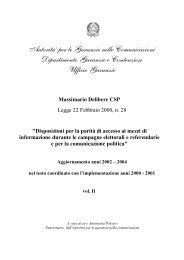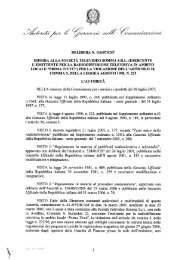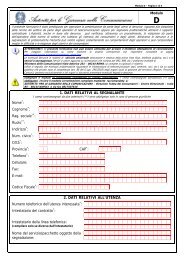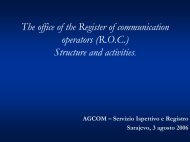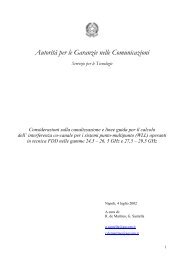Communications Regulatory Authority
Communications Regulatory Authority
Communications Regulatory Authority
Create successful ePaper yourself
Turn your PDF publications into a flip-book with our unique Google optimized e-Paper software.
– “Smart” services characterised by a special price determination system based<br />
on the smart network of each operator. This category includes premium services,<br />
shared charge services, free phone numbers and one-number services;<br />
– Information services (such as directory assistance or information retrieval) and<br />
the so-called STS (Supplementary Telephony Services, such as Memotel,<br />
personal numbers, etc.).<br />
Table 1.3. Traffic of fixed voice services by type (million/minutes)<br />
Type of traffic 2004 2005<br />
Local * 53,790 52,281<br />
% Var. -3.7 -2.8<br />
Long distance – National 42,060 40,167<br />
% Var. -4.5 -4.5<br />
Fixed-to-mobile 20,041 20,142<br />
% Var. 4.5 0.5<br />
International 3,633 3,596<br />
% Var. -0.7 -1.0<br />
Other ** 3,244 3,299<br />
% Var. 1.3 1.7<br />
Total 122,768 119,484<br />
% Var. -2.5 -2.7<br />
Source: IDC, 2006 | * Internet dial-up access excluded. ** Smart services, information<br />
services and STS included<br />
In this regard, it is important to point out that in 2005, following the opening of the<br />
market to competitors many operators launched their information services for<br />
subscribers. The liberalization of the service, decided at community level and envisaged<br />
in the Code of electronic communications, produced the entry into the market of many<br />
operators as well as the launch of massive advertising campaigns. AGCOM intervened<br />
on the liberalization of the information service not only with the opening to the<br />
provision of the service by a plurality of economic agents but also by laying down rules<br />
and monitoring their effectiveness in order for the market to be really competitive: such<br />
activity introduced interventions such as the reduction of the ceiling prices of calls for<br />
directory assistance information services from fixed lines and the introduction of<br />
restrictive regulations for call completion (cf. paragraph 2.2.).<br />
As regards telephones lines installed, it can be estimated that in 2005, in Italy, there<br />
were about 27.4 million lines (PSTN/ISDN) (figure 2.6.). In the same way as it occurred<br />
in 2004, last year as well there has been a significant drop in the number of ISDN lines<br />
(-6%, totalling about 400,000 lines), which have been replaced by the adoption of<br />
broadband accesses, especially in ADSL technology. PSTN lines (figure 1.21.) show a<br />
slight decrease (-0.7%).<br />
57




